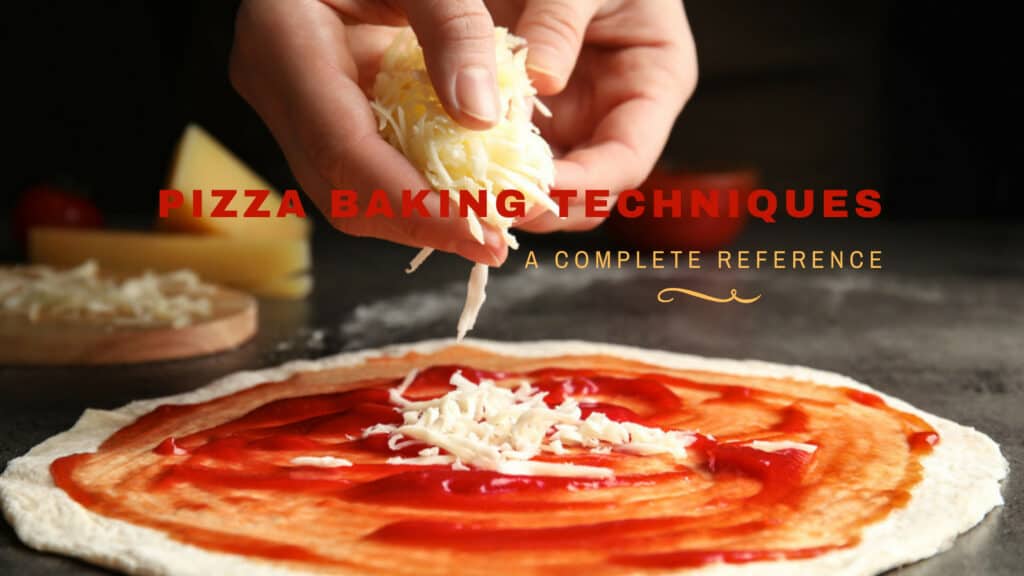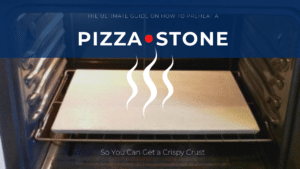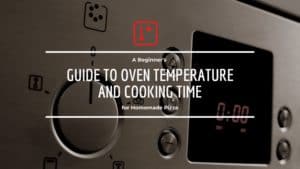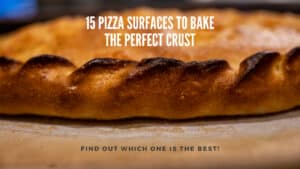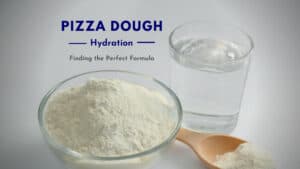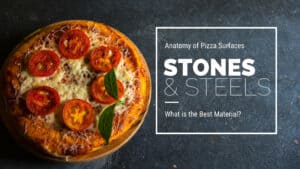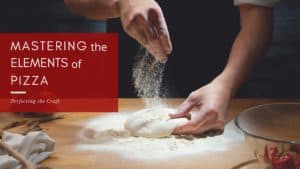Pizza – a word that instantly brings to mind the aroma of fresh dough, tangy tomato sauce, and melted cheese. Originating in Naples, Italy, pizza has evolved over the centuries, making its mark on nearly every culture and cuisine worldwide. It’s more than just a food item; it’s a canvas for culinary creativity, a communal dish that brings people together, and, most importantly, a testament to the joys of simple, good food.
While it’s easy enough to dial up your favorite pizza place, nothing compares to the sense of achievement and deliciousness of a homemade pizza. The crust, sauce, and toppings can be customized exactly to your liking, and the process itself is a rewarding experience.
We will embark on a journey into the heart of pizza making, unraveling the secrets behind the perfect dough, sauce, and toppings. We’ll explore pizza baking techniques straight from the streets of Naples, as well as tips from professional pizzaiolos and home cooks alike.
Whether you’re an experienced home baker or a novice in the kitchen, these techniques and tips will elevate your pizza-making game. Let’s roll up our sleeves and start on the path to pizza perfection!
Let’s get started!
Here’s What You Will Find:
Welcome to the heart of our comprehensive guide: the techniques of pizza baking. From kneading the dough to pulling the perfect slice from the oven, each step is a chance to shape the final product—your delicious creation. Pizza baking is as much a craft as it is a cooking process, requiring attention, care, and a bit of flair.
Whether you’re a first-timer looking to craft a simple Margherita or a seasoned chef experimenting with innovative toppings and sauces, these techniques will be your map to creating pizzas that are as enjoyable to make as they are to eat.
Let’s dive in and uncover the magic behind each delicious slice.

Pizza Making Techniques
We’ll delve into the core pizza making techniques used by home cooks and professional pizza chefs alike. We’ll explore methods such as hand kneading, proofing, docking, pre-baking, and more. We’ll talk about tools of the trade like pizza stones and peels and the impact of high-temperature baking.
And of course, we’ll walk through the importance of the finishing touches, like broiling and allowing your pizza to rest before that first mouth-watering bite.
Pizza Making Techniques
- Hand Kneading Dough: This is a manual method of mixing and working the dough to develop gluten, which gives the crust its structure. Kneading helps distribute the yeast evenly and promotes a good rise in the oven.
- Hydration: Hydration refers to the ratio of water to flour in the dough, typically expressed as a percentage. A higher hydration (more water) results in a dough that’s more sticky and difficult to handle but can produce a lighter, airier crust with a more open crumb structure. Conversely, lower hydration (less water) results in a dough that’s easier to handle and can produce a denser, more bread-like crust. The ideal hydration level can vary depending on many factors, including the type of flour used, the baking method, and personal preference.
- Autolyse: This pizza making technique involves mixing the flour and water and letting it sit for some time before adding the yeast and salt. This process helps to hydrate the flour and start the gluten development, resulting in a dough that is easier to shape and has better texture and flavor.
- Proofing: Also known as fermentation, proofing is the resting period that allows the dough to rise and develop flavor. This pizza making technique can occur over a few hours or even days, depending on the recipe.
- Fermentation: After preparing the dough, it’s allowed to ferment or rise. During fermentation, yeast consumes the sugars in the dough, producing carbon dioxide gas and alcohol, which contribute to the dough’s flavor and texture. The process can be done at room temperature, or for better flavor development; it can be done in the refrigerator over a longer period (cold fermentation).
- Cold Fermentation: After mixing the dough, it’s placed in the refrigerator for a slow rise over one to several days. This pizza making technique allows for more complex flavors to develop in the dough.
- Degassing: This is the process of gently pressing down the dough after it has risen to remove large air pockets while still maintaining its lightness. This step helps to create a more even texture in the dough before it’s rolled and stretched.
- Windowpane Test: This is a method for checking if the dough has been sufficiently kneaded. A small piece of dough is stretched out to see if it can become thin enough to be translucent without tearing – like a windowpane. If it can, the dough has developed enough gluten and is ready for the next steps.
- Rolling and Stretching: Rolling and stretching the dough by hand helps to shape the pizza while maintaining its light, airy structure. The technique requires a delicate touch to avoid overworking the dough and to ensure the edge or ‘cornicione‘ remains thicker to form the perfect crust.
- Bench Resting: After initial kneading and before final shaping and stretching, the dough is often left to rest for a short period of time, usually 10-20 minutes. This rest (or bench rest) allows the gluten in the dough to relax, making it easier to shape without springing back.
- Using a Baking Steel: Similar to a pizza stone, a baking steel is a heavy steel platform that goes into your oven. It retains and evenly distributes heat more efficiently than a stone, which can lead to better oven springs and crisper crusts. Preheating the steel before baking is crucial to achieve the right baking temperature.
- Balancing Toppings: Instead of randomly scattering toppings over the pizza, consider their flavor profiles, moisture content, and how they’ll cook. Distribute them evenly to ensure every slice has a good balance of flavors and textures. Some ingredients might be added after the pizza is cooked to keep them fresh or to avoid burning.
- Docking: This pizza making technique involves creating small holes in the dough using a docker or fork before baking, preventing it from puffing up excessively and allowing for a more even bake.
- Pre-Baking: Also known as “par-baking,” this technique involves partially baking the crust before adding the toppings. This method is useful for a crispy crust and fully cooked through.
- Using a Pizza Stone: These are tools designed to mimic the conditions of a professional pizza oven. They absorb and retain heat well, producing a well-baked crust with a superior texture.
- Baking at High Temperature: Pizzas are usually baked at high temperatures (often 475-500 degrees F or even hotter) for a relatively short time. This pizza baking technique results in a crisp exterior and soft interior and also promotes “oven spring,” which gives the crust its desirable light, airy texture.
- Using a Pizza Peel: A pizza peel is a tool used to slide the pizza into and out of the oven, minimizing the risk of misshapen pizzas or burns. It takes some practice to use effectively.
- Turning the Pizza: Turning the pizza during baking ensures it cooks evenly, as most ovens have hot spots. This can be done with a pizza peel or a pair of long tongs.
- Finishing with a Broiler: To achieve a beautifully bubbled and browned cheese topping, some pizza makers finish off the pizza under the broiler for a minute or two.
- Saucing: Applying the right amount of sauce correctly is critical. Too much can make the pizza soggy, and the sauce should generally not quite reach the edges of the dough.
- Cheesing: Cheese can be applied in various ways, but often, it’s put on in an even layer over the sauce. Some pizza styles call for cheese first, then sauce, while others might call for dollops of cheese scattered about.
- Using a Pizza Peel: This is a tool used to transfer the pizza to and from the oven. The pizza is assembled on a well-floured peel and then launched onto the preheated baking stone or steel in the oven.
- Checking and Turning: During baking, the pizza should be checked periodically and turned as needed for even cooking. This is where the peel often comes in handy again.
- Resting Before Cutting: After the pizza comes out of the oven, it’s beneficial to let it rest for a few minutes. This allows the cheese to set a bit, preventing it from sliding off when you cut into the pizza. It also allows the crust to crisp up a bit more as it cools.
- Garnishing: Garnishing refers to adding ingredients to the pizza after it has baked. This could include fresh herbs, a drizzle of olive oil, or a sprinkle of freshly grated hard cheese. Garnishing not only adds flavor but also enhances the visual appeal of the pizza.
This guide to pizza making techniques is just the beginning, the crust on your journey to pizza perfection, if you will. We encourage you to explore all the related articles listed below, each one another step on the path to mastering the art and science of pizza.
From dough formulation to pairing beverages, let your curiosity guide you through these wisdom slices. The pizza world is vast and flavorful, so roll up your sleeves, stoke your oven, and dive in deeper—you’re in for a delicious adventure!
Search Pizza Baking Techniques by Category
Pizza Baking Techniques
Pizza baking is more than a method; it’s a tradition passed down through generations, a mix of science and heart, a dance between ingredients and oven. Each step – from kneading the dough, choosing your toppings, mastering the bake, to finishing off with just the right touch – is a crucial part of creating the pizza magic.
The pizza baking techniques explored in these pages will provide a foundation of knowledge that allows your creativity and passion to take center stage.
Whether you’re striving to replicate the wood-fired pizzas of Naples, the deep-dish wonders of Chicago, or inventing a fusion delight that’s uniquely yours, the tools and tips here will guide you.
So, preheat your ovens, dust off your pizza stones, and let’s dive into the delicious, savory universe of pizza baking techniques.
Your culinary journey toward pizza mastery starts now.
Pizza Baking Techniques:
How to Use a Pizza Stone on a Grill (#1 Beginner’s Guide)
the PROs
How to Use a Pizza Stone on a Grill Quick question: do you know how to use a pizza stone on a grill? A pizza stone is a worthwhile investment if you love baking pizzas at home. But is pizza stone usage restricted to pizza ovens? We think not! They’re …
How to Cook Frozen Pizza in Ooni Pizza Oven (Step by Step)
the PROs
How to Cook Frozen Pizza in Ooni Pizza Oven After a tiring day at school or work, we all want a quick snack to grab to satisfy our hungry tummies. Frozen pizza is our way to go! Although freshly-made pizzas have the magic of authentic pizza flavor, sometimes we don’t …
How to Reheat Pizza in Oven Like a PRO!
the PROs
There’s nothing quite like enjoying a slice of leftover pizza, but finding the perfect method how to reheat pizza can be a game-changer. Imagine taking your cold, lifeless pizza and transforming it back into the mouthwatering, cheesy, saucy delight it once was. Well, you’re in luck! Today’s post is dedicated …
Pizza Temperature and Time: The Ultimate Cheatsheet
the PROs
Pizza Temperature and Time To bake pizza to the “T” requires the correct pizza temperature and time. The recommended temperature for an oven pizza is between 250 to 260 degrees C or 450 to 500 degrees F. It takes about 10 to 15 minutes to bake a pizza whose crust …
How to Preheat a Pizza Stone: The Ultimate Guide
the PROs
It’s a universally acknowledged truth that nothing quite matches the tantalizing aroma and delectable taste of a homemade pizza, crisped to perfection. However, that perfect crunch and the evenly baked base aren’t just the results of a good dough or the perfect blend of toppings. It’s the magic of a …
How to Season a Pizza Stone the Right Way!
the PROs
How to Season a Pizza Stone Are you wondering how to season a pizza stone? Today, we’ll look at how to season a pizza stone so your pizza won’t stick. If you have recently purchased a pizza stone, you are one step closer to improving your pizza skills. A pizza …
Everything You Need to Know on How to Use a Pizza Stone for the First Time
the PROs
How to Use a Pizza Stone for the First Time If you are a pizza lover, you may wonder how to use a pizza stone for the first time to make a crunchy and delicious pizza at home. The good news is that it isn’t as tricky as you think. …
Can You Bake Pizza on Silpat? Yes, You Can! Here’s What You Need to Know
the PROs
Good news! You can use plenty of methods to get the best pizza results from the comfort of your home. But what about silicone baking mats? Can you bake pizza on Silpat? And is it worth it? Silicone baking mats are among the best and cheapest ways to recreate wood-fired …
Ditch the Pizza Stone and Cook Your Pizza on Parchment Paper
the PROs
Can You Cook Pizza on Parchment Paper? Baking Pizza on Parchment Paper As pizza enthusiasts with countless pies under our belt, we understand the insatiable craving for that perfect homemade pizza. But did you know that parchment paper can be your secret weapon in achieving the best pizza? In this …
Pizza Stone vs Steel: Discover Which One You Need to Make the Perfect Pizza!
the PROs
Discover the difference between a pizza stone and pizza steel, why you need one, and find which is best for you for the perfect pizza!
How to Dominate Oven Temperature and Cooking Time for Pizza
the PROs
This beginner’s guide will help you set the best temperature and cooking time for your homemade pizza. Even for frozen pizza!
Insanely Powerful Pizza Stone Alternatives that will Give You the Best Crust
the PROs
Find 15 alternatives for a pizza baking surface. You may be surprised as some of them you may already own and some may take you for a spin.
Is Your Pizza Dough Not Smooth? Here’s What You Need to Do
the PROs
Are your pizza dough balls not smooth? If you’ve ever found yourself kneading away at your pizza dough, only to be met with a texture that’s far from the smooth, elastic consistency you were aiming for, then this post is for you. The uneven, lumpy, or excessively sticky dough can …
Pizza Dough Hydration – Mastering the Art of the Perfect Crust!
the PROs
If you’re looking to get the best results, this scientifically proven formula to calculate, manage and control pizza dough hydration will get you on track to become the best pizza baker! So, let’s get started.
Here’s the Secret to Making the Perfect Crispy Pizza Crust
the PROs
Are you tired of making homemade pizza that has a crust that never seems to get crispy enough? We’ve got the answer to this problem! Our assortment of tips and methods will solve your problem once and for all. You’ll get better results in how to make a pizza crust crispy and crunchier than ever! So, let’s find out!
Are Frozen Pizzas Precooked? Find the Truth and How to Bake the Best Frozen Pizza!
the PROs
Have you ever been curious to find out what it takes to make the best frozen pizza at home? Many people also have big questions when it comes to the issue of whether or not your pizza is precooked. In this article we cover it all.
Cooking with Fire: The Best Fuel for Your Ooni Pizza Oven
the PROs
If you like to know which is the best fuel source for the Ooni pizza oven, look no more. Explore different fuel sources and find the best!
How to Control Temperature, Time, and Hydration for Pizza Dough
the PROs
Learn how temperature, time and hydration affect pizza dough and how you can control them.
Pizza Stone Heat Retention [Best Pizza Stone Material]
the PROs
Read about pizza stones heat retention and distribution properties, their pros and cons, and which stone might work best for you!
What is a Pizza Stone? Discover the Secret to Perfect Crust Every Time!
the PROs
Do you want to achieve the perfect pizza crust? Now you can. This revamping tool will be the key to the crust you crave.
What is a Pizza Stone Made Of? Discover the Fascinating Anatomy of Pizza Stones
the PROs
In this article find out what pizza stones are made of, explore the different materials and find which one the best for you.
Pizza Stones FAQs: 15 Burning Questions That You Need to Know the Answer
the PROs
Know the answer to 15 pizza stones FAQs that you should know. You asked and we answer your concerns about pizza stones and more.
How to Make Pizza Like a PRO! The Easy Way
the PROs
In this article, we’ll talk about how making pizza at home is better than getting pizza from a restaurant and how you can make pizza like a pro at home without any hassle or problems. We’ll talk about different types of pizza, the ingredients you’ll need, and the instructions for …
The Easy Way to Have a DIY Pizza Oven
the PROs
Discover the tricks and tweaks you can do to your oven to transform it into a professional pizza oven. Better yet, the pizza will be amazing, because it’s made by you!
Master the Pizza Making Process Controlling these Powerful Pizza Elements
the PROs
Master the pizza craft with this guide, discover the elements of pizza and become a master pizza baker once you dominate these elements.
Enjoy!
Not a PRO? Not a Problem!
Take a pizza class to bring your pizza skills to the next level,
so you can be a PRO!
Related Posts

Costco Pizza Delivery: Find How You Can Get It Now!
the PROs
People go to Costco’s food court for many different reasons, but the cheesy slice of pizza they serve is among …

Pizza for Beginners: Don’t Buy Pizza, Make It! Here’s How to Get Started!
the PROs
You have this idea that you want to make pizza at home as opposed to ordering it, but where do you start? Don’t worry! Here you will find answers and directions to all your questions.

Pizza Toppings Under Cheese or Over Cheese? [Why the Order Matters]
the PROs
Is Pizza Cheese on Top or Bottom? Hey pizza lovers, are you wondering if you should layer pizza toppings under …
Newsletter
Subscribe to our Recipe of the Week newsletter and receive our partners’ latest recipes, tips, and discount offers.
Keep in Touch!
